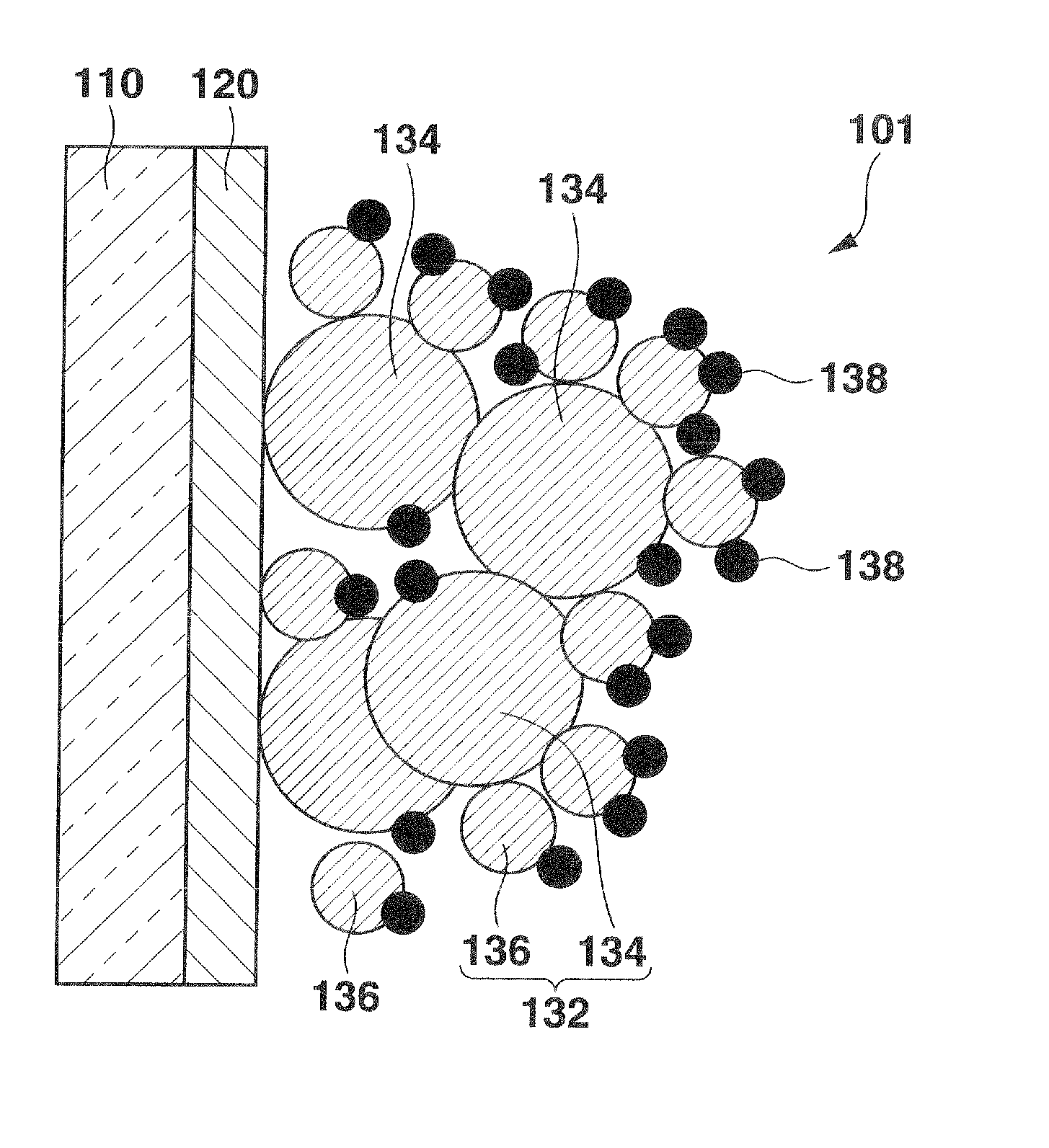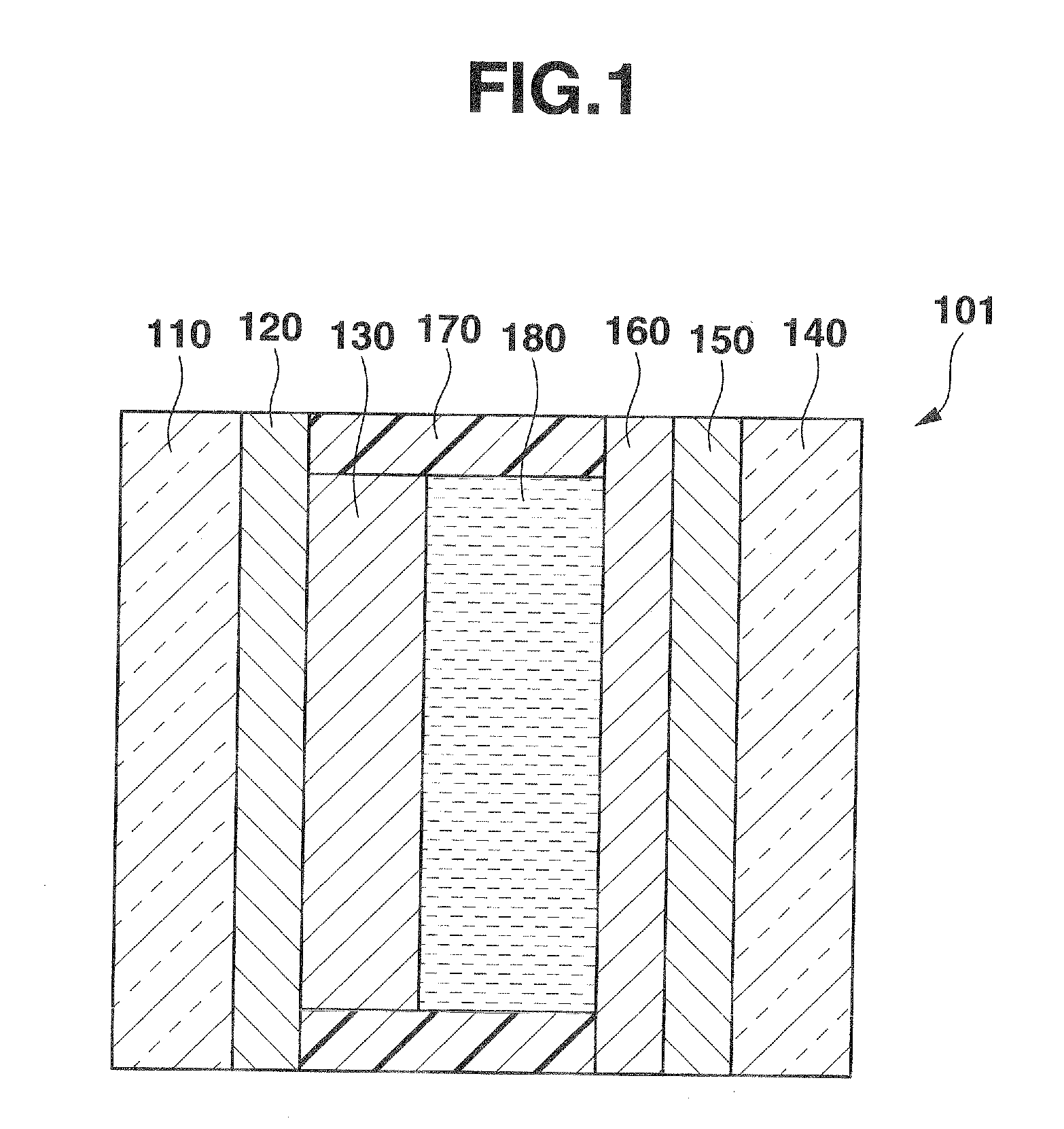Dye-sensitized solar cell
- Summary
- Abstract
- Description
- Claims
- Application Information
AI Technical Summary
Benefits of technology
Problems solved by technology
Method used
Image
Examples
first embodiment
[0026]A first embodiment of the present invention will now be described with reference to the drawings. In a dye-sensitized solar cell 101 according to the first embodiment, a transparent conductive film 120 as a first electrode made of indium tin oxide (ITO) or fluorine-doped tin oxide (FTO) is formed on a transparent first substrate 110 made of, for example, glass or a film, as shown in FIG. 1. The transparent conductive film 120 may be patterned. A current collector pattern made of silver may be provided as a layer above or below the transparent conductive film 120. An electron-collector / dye layer 130 is formed on the transparent conductive film 120. The electron-collector / dye layer 130 will be described in details later.
[0027]A conductive film 150 as a second electrode is formed on a transparent second substrate 140 which is made of, for example, glass or a film and opposed to the first substrate 110. A catalyst layer 160 made of platinum or carbon is formed on the conductive fi...
second embodiment
[0047]A second embodiment of the present invention will now be described below with reference to the drawings. In a dye-sensitized solar cell 201 according to the second embodiment, a transparent conductive film 220 as a first electrode made of indium tin oxide (ITO) or fluorine-doped tin oxide (FTO) is formed on a surface (a first surface) of a transparent first substrate 210 made of, for example, glass or a film, as shown in FIG. 5. The transparent conductive film 220 may be patterned. A current collector pattern made of silver may also be provided as a layer above or below the transparent conductive film 220. An electron-collector / dye layer 230 is formed on the transparent conductive film 220. The electron-collector / dye layer 230 will be described in details later.
[0048]The electron-collector / dye layer 230 comprises an electron collector including grains of, for example, anatase titanium oxide, and dye made of, for example, ruthenium dye (e.g., N719 dye). The electron collector h...
example
[0056]An example of the dye-sensitized solar cell 201 according to the second embodiment will now be described. In a dye-sensitized solar cell 201 according to the present embodiment, fine roughness was formed on a second substrate 240, and a surface of a catalyst layer 260 was formed as a diffusion / reflection surface. The dye-sensitized solar cell 201 of the present embodiment was compared with a dye-sensitized solar cell 290 as a comparative example in which a second substrate 240 was formed to be a flat surface and a surface of a catalyst layer 260 was formed to be a mirror surface. An index used for comparison was conversion efficiency η as a ratio of energy of generated electricity to energy of incident light.
[0057]In the dye-sensitized solar cell 201 according to the present embodiment, roughness was formed on the second substrate 240 by chemical polishing. A surface shape of the second substrate 240 which was formed to be rough is shown in FIGS. 6A and 6B. FIG. 6A is a plan v...
PUM
 Login to View More
Login to View More Abstract
Description
Claims
Application Information
 Login to View More
Login to View More - R&D
- Intellectual Property
- Life Sciences
- Materials
- Tech Scout
- Unparalleled Data Quality
- Higher Quality Content
- 60% Fewer Hallucinations
Browse by: Latest US Patents, China's latest patents, Technical Efficacy Thesaurus, Application Domain, Technology Topic, Popular Technical Reports.
© 2025 PatSnap. All rights reserved.Legal|Privacy policy|Modern Slavery Act Transparency Statement|Sitemap|About US| Contact US: help@patsnap.com



